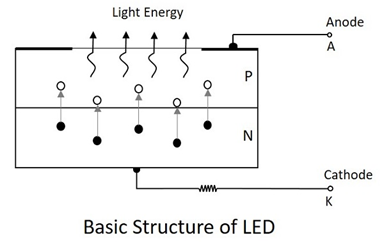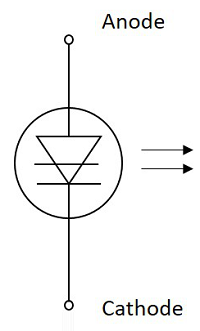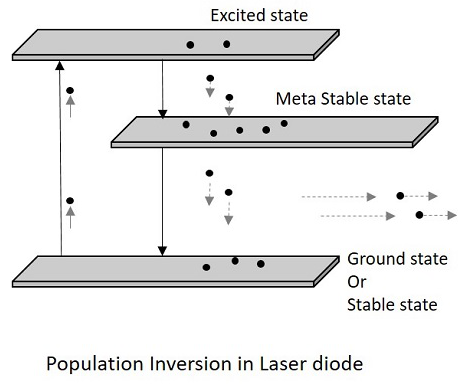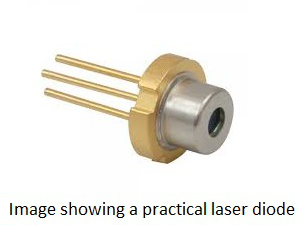LED (Light Emitting Diodes)
This one is the most popular diodes used in our daily life. This is also a normal PN junction diode except that instead of silicon and germanium, the materials like gallium arsenide, gallium arsenide phosphide are used in its construction.
The figure below shows the symbol of a Light emitting diode.

Like a normal PN junction diode, this is connected in forward bias condition so that the diode conducts. The conduction takes place in a LED when the free electrons in the conduction band combine with the holes in the valence band. This process of recombination emits light. This process is called as Electroluminescence. The color of the light emitted depends upon the gap between the energy bands.
The materials used also effect the colors like, gallium arsenide phosphide emits either red or yellow, gallium phosphide emits either red or green and gallium nitrate emits blue light. Whereas gallium arsenide emits infrared light. The LEDs for non-visible Infrared light are used mostly in remote controls.
The following figure shows a how the practical LEDs of different colors looks like.

LED in the above figure has a flat side and curved side, the lead at the flat side is made shorter than the other one, so as to indicate that the shorter one is Cathode or negative terminal and the other one is Anode or the Positive terminal.
The basic structure of LED is as shown in the figure below.

As shown in the above figure, as the electrons jump into the holes, the energy is dissipated spontaneously in the form of light. LED is a current dependent device. The output light intensity depends upon the current through the diode.
Advantages of LED
There are many advantages of LED such as −
- High efficiency
- High speed
- High reliability
- Low heat dissipation
- Larger life span
- Low cost
- Easily controlled and programmable
- High levels of brightness and intensity
- Low voltage and current requirements
- Less wiring required
- Low maintenance cost
- No UV radiation
- Instant Lighting effect
Applications of LED
There are many applications for LED such as −
In Displays
- Especially used for seven segment display
- Digital clocks
- Microwave ovens
- Traffic signaling
- Display boards in railways and public places
- Toys
In Electronic Appliances
- Stereo tuners
- Calculators
- DC power supplies
- On/Off indicators in amplifiers
- Power indicators
Commercial Use
- Infrared readable machines
- Barcode readers
- Solid state video displays
Optical Communications
- In Optical switching applications
- For Optical coupling where manual help is unavailable
- Information transfer through FOC
- Image sensing circuits
- Burglar alarms
- In Railway signaling techniques
- Door and other security control systems
Just as LED has many advantages and applications, there is another important diode called Laser diode, which also has got many advanced features and scope of future. Let us discuss about Laser diode.
Laser Diode
Laser Diode is another popular diode for its kind. This is an optical diode which emits light but with stimulated process. The name LASER implies Light Amplification by Stimulated Emission of Radiation.

Stimulated Emission
This is a PN junction diode whose action starts when a light ray is incident on it. With a light ray, when photons get incident on an atom, the atom gets excited and it reaches an upper level which can be termed as a Higher Energy Level.
The atom when shifts from the higher energy level to a Lower Energy Level, it releases two photons which are similar in characteristics to the incident photon and are in equal phase to it. This process is called as Stimulated Emission. An atom can generally stay in this excited state for 10-8 secs of time.
So, the above process sets the principle for laser diode.
Principle of Laser Diode
Whenever a photon is incident on an atom, that atom is excited from a lower energy state to a higher energy state and two photons are released in this process. Actually, an atom can generally stay at this excited state for 10-8 secs of time. So, in order to achieve amplification, during this excited process, the atom is made to be placed in another state called Meta Stable State which is below the higher energy level and above the lower energy level.
An atom can stay in this Meta stable state for 10-3 secs. While the atom gets to the lower state from this, two photons are released. If more number of atoms are there in the excited state, prior to the photons striking the atoms, then we have the Lasing Effect.

In this process, we have two terms to understand. Having more number of atoms at Meta Stable state than the lower energy state or ground state is called as Population inversion. Then energy that lets the atoms to send from a lower energy state to a higher energy state to achieve the population inversion, is called as Pumping. This is Optical pumping.

Advantages
There are many advantages of Laser diode such as −
- Power used by laser diodes is much less
- Higher ON/OFF switching speed
- More Compact
- Less expensive
- They are cheaper than laser generators
- Less chances of providing electrical shocks
Disadvantages
There are few disadvantages of Laser diode such as −
- More divergent rays and hence quality is not so good
- Their life time is less compared to LED.
- Prone to damage during unstable power supplies
Applications
There are many applications of Laser diode such as −
- Used as pump-laser and seed-laser
- Used in optical data storage devices
- Used in laser printers and laser fax machines
- Used in Laser pointers
- Used in bar-code readers
- They are used in DVD and CD drives
- Used in HD DVD and BLU RAY technology
- Has many industrial purposes such as heat treating, cladding, seam welding etc.
- Has got many uses in communication technology such as data linking and transmission.
After going through all these, let us try to understand few terms.
Component
- The Components are the individual basic elements of electronics.
- They have different properties with respect to their construction.
- Every component has different applications.
Ex − Resistor, Capacitor, Diode etc.
Circuit
- A Circuit is a network of different components
- The components in the circuit altogether, survive an intended purpose.
- If a circuit has to be active, should contain a power source.
Ex − clipper and clamper circuits, amplifier circuits, relay circuits etc.
Device
- A Device is an equipment that is made up of different circuits.
- All circuits in the device help it function to serve its purpose.
- A device can be used for measuring signals, generating signals, controlling the outcomes or protecting the circuits and so on.
Ex − CRO, Function generator etc.
Solid State devices
Previously we used to have vacuum tubes, which work on thermionic principle and are filled with vacuum inside. They were bigger in size than today’s components. These vacuum tubes were replaced with semiconductor devices, which are also called as Solid state devices.
Active Devices
The devices (or precisely components) which can control the current flow can be termed as Active Devices.
- They require some input power supply to get into conduction.
- The working of these components define the behavior of the circuit.
Ex − Vacuum tubes, diodes, transistors, SCRs
Passive Devices
The devices (or precisely components) which cannot control the current flow can be termed as Passive Devices.
- They don’t require input power supply to work.
- The working of these components slightly alters the circuit’s behavior.
Ex − Resistor, Capacitor, Inductor etc.
Doping
The process of adding of electrons or creating holes to alter the characteristics of the semiconductor material, either by making more positive or by making more negative can be understood as Doping.
The applications of diodes include many circuits starting from clipper and clamper circuits, which will be discussed in ELECTRONIC CIRCUITS tutorial.






